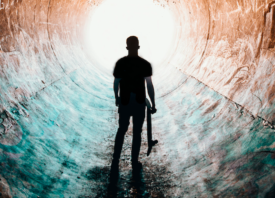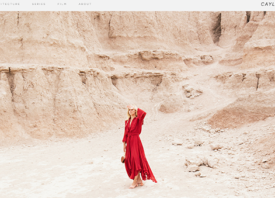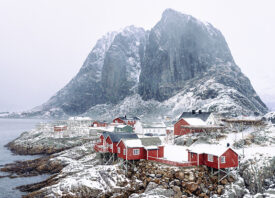Search this site
Inside the Colorful Mind of One Traveling Photographer (Sponsored)

Scroll through Kevin Krautgartner‘s Squarespace website, and you’ll find yourself asking, “Is that real?” The German-based photographer has traveled the globe, tracking down some of the most surreal natural wonders and uncanny architectural details imaginable, transforming them into one-of-a-kind, candy-colored confections for the eye. With a background in graphic design, he has an impeccable knack for noticing unusual forms and elements, accruing tens of thousands of followers and drawing the attentions of photo editors around the world.
As he gained traction and popularity for his minimal architectural shots as well as his aerial landscapes, Krautgartner had big plans in the works. His photographs are beautiful on the screen, but they’re also meant to be seen in person. For that reason, the artist created an online store. Fully integrated into his vibrant Squarespace website, this fully-realized PrintShop gives photography lovers the chance to own their favorite images. Not all of us can travel halfway across the world at a moment’s notice, but through Krautgartner’s store, anyone can take home a piece of an Australian salt lake, the tulip fields of the Netherlands, the sweeping skyline of Dubai, or even a grand German concert hall.
We interviewed Krautgartner about his award-winning work, and along the way, he gave us some insight into the inner workings of his website and store. With his shop up and running, Krautgartner can turn his attention to what matters most: making more images of unique places from seemingly unimaginable vantage points. Opening a new business can be daunting, especially for an artist, but this photographer shows us just how easy it can be to build your way to success using Squarespace web hosting.
What were you looking for when you were researching website builders, and why did you choose Squarespace?
“For me as a photographer, the presentation of my artwork is the key factor when it comes to build a website. Aside from that, I also don’t want to spend too much time in programming a huge website, as I want to focus on my photography projects. Squarespace gave me the opportunity to build a good-looking website that is easy to edit. Squarespace’s focus on artists was a major draw for me, as it incorporates every feature I need, not least of which is an online store.”
Why did you decide to set up a print store under your domain, and what’s been the most rewarding aspect of selling your work online?
“For me, the greatest thing in photography is to see the final result as a Fine Art print. My aerial works, in particular, look amazing when they are printed large. All those small details which are visible from the air come alive on paper. I wanted to give the people who like my work to have the opportunity to hold a printed piece in their own hands. The print shop is the heart of my website.”
Can you tell us a bit more about the prints you have in the shop?
“I’m selling my works printed on three different materials: Fine Art paper, Alu-Dibond and Acrylic glass. Each of them comes in several sizes. As I’m delivering a very high-quality product, I work very closely with one of Germany’s best printers. They also print artworks for top galleries around the whole world. Right now, I’m working on a few special series, which will be offered as limited editions. There will also be some new artworks which are photographed with 100 MP cameras. These will be available as very large-scale prints.”

Does your approach change at all when you photograph manmade structures (architecture) versus natural landscapes (aerials)?
“I work with architectural projects and on landscape projects in a very different way. With the latter, I try to focus on unique and surreal structures, as well as interesting colors and accents. I like to take photos of landscapes which are not common to the viewer, and that’s also is the reason why I take photos from the air. When it comes to architecture, I’m focused on symmetries, lines, and shapes. In this case, it is important for me to be in the perfect position with the camera. The right angle is key; therefore, I often use tilt-shift lenses.”

What location has been the most satisfying for you to shoot?
“Within the past few years, I’ve seen so many amazing and unique places that it’s really hard for me pick out one location. But I think it has to be Shark Bay in Western Australia. I went flying above this area in a small Cessna with the rear doors removed to photograph, and I can tell you: I’ve never seen such an impressive landscape before. All the tidal flats, red sand beaches, and salt ponds just looked so unreal from above. Definitely have to go there again!”
How do you find these architectural gems to begin with?
“I do a lot of my research with architectural magazines and online articles. In order to find interesting buildings which are not photographed that often, you also have to take a look at some faraway countries. China, for example, has some amazing buildings, and most of them are not that popular. I think when you keep your eyes open and travel to different big cities, you’ll find endless locations.”

Why do you think minimalism has become so popular in recent years?
“This is a good question. Well, I think that minimalism has become so popular because because we are just flooded with digital media, and of the time, that media is cluttered with information, colors, and objects. More and more people, including myself, want to escape those kinds of visuals, and they want to see the opposite of that, especially when is comes to fine art. A reduced, well-composed photo is a piece of art that stands out. It’s beautiful because it’s just a bit unnatural.”
Similarly, how do you think the prevalence of drones and aerials has changed the way we understand landscape photography?
“Drone photography has opened a whole new perspective in photography. I think that we are just at the starting point when it comes to what these “flying cameras” will bring us in the future. Because of quality reasons, I prefer to take photos from a small plane or a helicopter, but most of the landscapes I want to shoot are not accessible by plane. A drone always was the missing brick in the camera industry, so I’m really excited to see what the technology will bring us the next years. Maybe a full frame camera? Who knows.”

You’ve photographed some places that are under threat from climate change. Does this context ever inform the way you think about these images or the way you present them?
“Well, I was horrified when I visited Iceland for the second time. One glacier had lost 20 meters in height in just two years! This really is a problem and has to stop. But to be honest, I’m not necessarily focusing on showing climate change in my photos. For me and my photos, it’s always interesting to see and capture moments where the landscapes of the world have changed, but this can also be due to natural changes a storm, a volcanic eruption, or something like that. Like I said before, I’m trying to capture atypical landscapes.”
What tips would you give to emerging photographers about building an online presence like you have?
“The most important thing is to do what you like. Photographing what you love is the key factor. It’s so important because that’s what will push you to do more. Good photos will follow. Besides growing your portfolio, you should use several platforms to present you work: it can be a solid website, Instagram, Facebook, etc. Stick to it, and it’s just a matter of time before your community starts to grow.”
Get started with your Squarespace website today and use the code FEATURESHOOT to get 10% off your first purchase.
Squarespace is a Feature Shoot sponsor.



